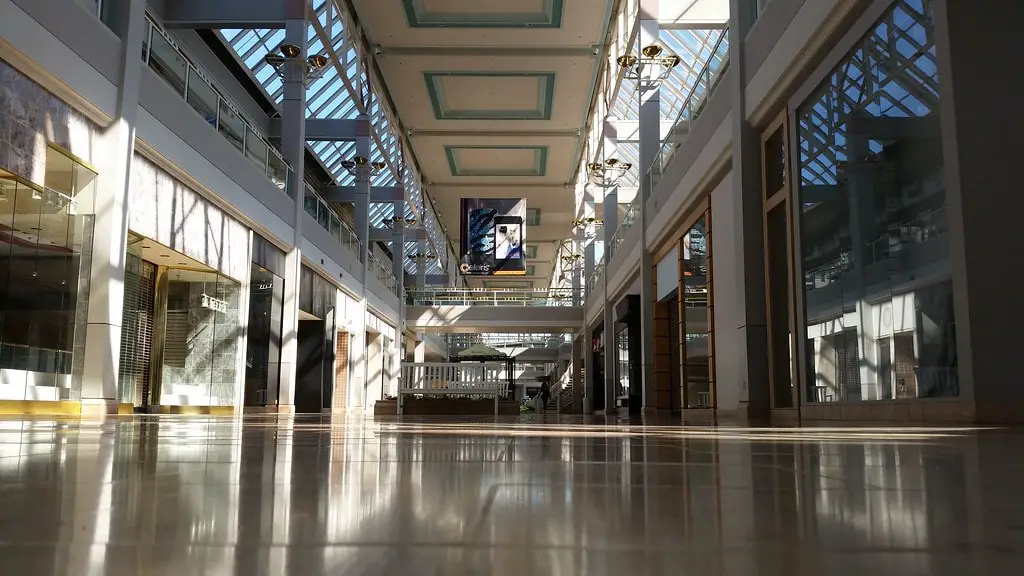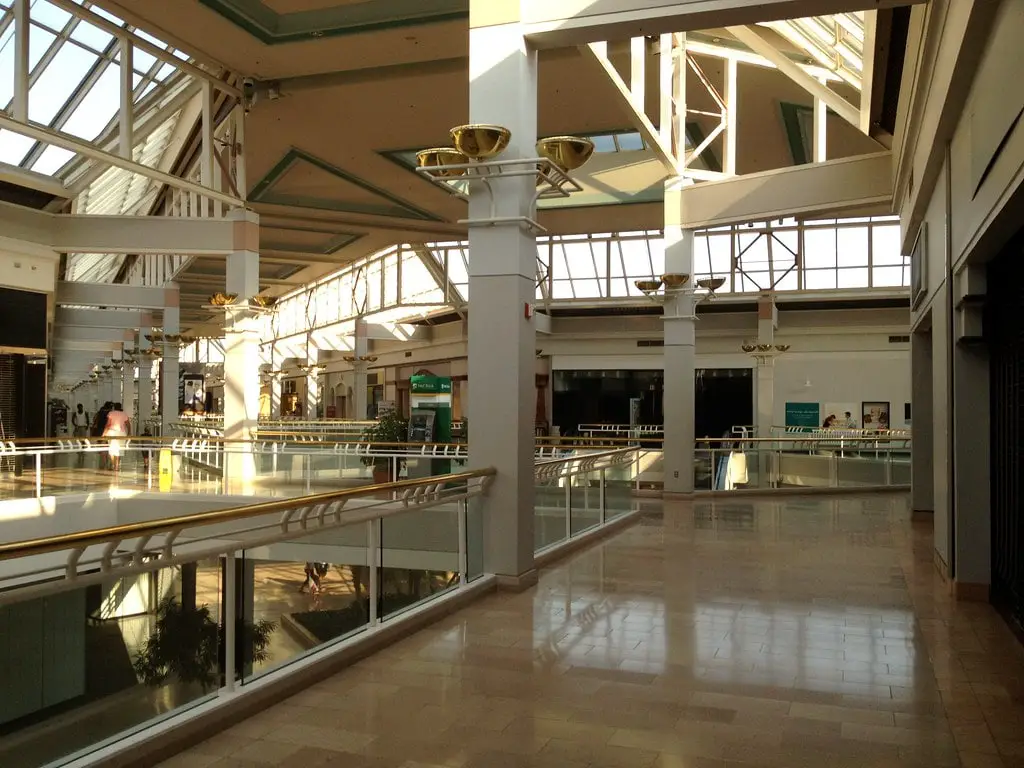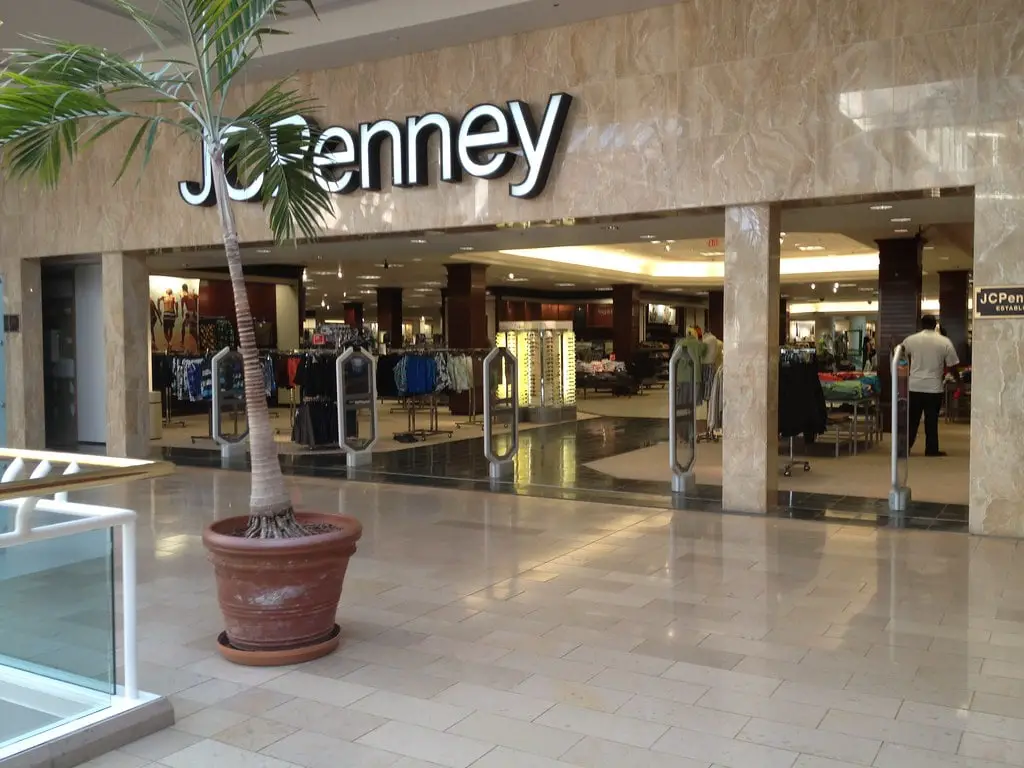The Birth of Owings Mills Mall
Once upon a time, in the summer of 1986, Owings Mills Mall opened its doors to the public. Developed by The Rouse Company, it was initially called Owings Mills Town Center.
The original plan was to build the mall around a lake, but that idea was dropped due to environmental concerns.
So, the mall settled for a more traditional layout but with a touch of luxury. At that time, malls were the social hubs of communities, and Owings Mills Mall aimed to be the crown jewel of Owings Mills, Maryland.
With its grand opening on July 30, 1986, it aimed to offer something for everyone. From fashion to food, the mall was a one-stop destination for retail.
The mall’s architecture was a sight to behold. It featured skylights, fountains, and a grand piano in the center court. The design was meant to create an atmosphere of elegance and comfort, making shopping an experience rather than a chore.
The mall was off to a flying start. It was 95% leased, and 80% of the stores were open on the first day. The anchor stores were Bambergers, Saks Fifth Avenue and Hecht’s, synonymous with quality and luxury back in the day.
Upscale stores like Williams Sonoma and Benetton were among the initial tenants. These stores catered to the affluent residents of Owings Mills and the surrounding areas to be a high-end shopping destination.
In the early days, the mall was bustling with activity. Families would spend weekends there, teenagers would hang out after school, and couples would go on shopping dates. Owings Mills Mall was the place to be, and it seemed like nothing could go wrong.

The Golden Years: Anchors and Upscale Tenants
The late ’80s and early ’90s were the golden years for Owings Mills Mall. Anchor stores made the mall more appealing to shoppers looking for high-end brands. It acted like a magnet, pulling in crowds and boosting sales for smaller stores in the mall.
Fashion shows, holiday events, and other special promotions were regular occurrences. The mall was not only a shopping destination but also an entertainment hub. It was the go-to place for things to do in Owings Mills, Maryland.
However, all that glitters is not gold. While the mall was thriving, it was also facing challenges. The retail landscape was changing, and competition was heating up.
Despite these challenges, Owings Mills Mall continued to hold its own. It underwent several renovations to keep up with the times.
New stores were added, and existing ones were upgraded. The mall was adapting, but the winds of change were blowing stronger than ever.
By the late ’90s, the mall started showing signs of wear and tear. Some upscale tenants began to leave, replaced by more budget-friendly stores. The shift in the tenant mix was a sign of the changing times and the challenges ahead.
Still, the mall remained a popular destination. It was a place where people could shop, dine, and have a good time. But the golden years were ending, and a new chapter was about to begin.

The Metro Connection and Public Transport
In 1987, a year after the mall opened, the Owings Mills Metro Subway Station was inaugurated. Initially, a shuttle bus service connected the mall to the Metro station.
This significant development made the mall more accessible to people from different parts of the city.
However, the shuttle service was discontinued in 1992. This decision hurt the mall’s foot traffic. People, especially those who relied on public transport, found it less convenient to visit.
The lack of a direct Metro connection became a significant drawback. It made the mall less appealing to potential visitors, especially those with other, more accessible options.
This was one of the factors that contributed to the mall’s decline in the years that followed.
Accessibility is crucial in today’s fast-paced world. People want convenience, and the easier it is to get to a place, the more likely they are to visit.

Crime and Perception: The Christina Brown Murder
In 1992, a tragic event would forever change the perception of Owings Mills Mall. Christina Brown was murdered along the pathway between the mall and the Metro station.
This incident sent shockwaves through the community and had a lasting impact on the mall’s reputation.
The murder increased security measures, including better lighting and more frequent patrols. However, the damage was done. The mall was now seen as unsafe, especially during the evening hours.
Local media covered the incident extensively, further fueling the perception that the mall was unsafe. This negative publicity blew the mall’s image, one from which it would never fully recover.
The mall could not shake off the stigma despite improving security and changing public perception. The murder of Christina Brown was a turning point for Owings Mills Mall.
It was a tragic event with far-reaching consequences, casting a long shadow over the mall’s future.

The Decline and Closure of Owings Mills Mall
The early 2000s were a challenging period for Owings Mills Mall. Competition from other shopping centers like Towson Town Center was fierce.
Moreover, shifts in the socio-economic climate of the surrounding community were affecting the mall’s performance.
By 2010, the mall was struggling to keep its doors open. It was 22.6% vacant, a far cry from its heyday when it was 95% leased. Many stores had shut down, and the mall was a shadow of its former self.
In September 2015, the inevitable happened. Owings Mills Mall closed its doors for good. It was the end of an era, a sad moment for the community that had once considered the mall a second home.

The closure had a ripple effect on the surrounding area. Other businesses that relied on the mall’s foot traffic also suffered.
It was a tough time for the community, as a place that had once been a hub of activity was now an empty shell.
The mall’s decline was a complex issue, influenced by multiple factors. A combination of challenges led to its downfall, from competition and changing consumer habits to the lack of public transport and the perception of crime.
In the following years, the mall stood vacant, a reminder of what it once was. It was a sad sight but also an opportunity for a fresh start. And that fresh start came in the form of Mill Station.
The Transformation into Mill Station
2017, the mall was demolished, making way for a new development called Mill Station. The project was completed in 2019 and aimed to breathe new life into the area.
Major anchors like Costco, Lowe’s, and Giant Food were among the first to open their doors.
Mill Station is a 620,000-square-foot redevelopment of the former Owings Mills Mall. It features 670 parking spaces and is within walking distance of the Metro Centre, with over 500 residential units and a Metro subway stop.
The new development combines retail, dining, and entertainment options. Stores like Five Below, PetSmart, Marshalls, HomeSense, and Burlington are among the tenants, offering a range of products and services to the community.

Mill Station has also attracted a variety of dining options. From fast food to fine dining, there’s something for everyone. It’s a place where families can spend a day shopping, eating, and having fun.
The redevelopment has been well-received by the community. It’s a sign of renewal, a fresh start for an area with many challenges. Mill Station is not just a shopping center; it’s a symbol of resilience and transformation.
As of October 2023, Mill Station continues to thrive. It’s a testament to the community’s ability to adapt and grow, turning the page on a chapter filled with ups and downs. Mill Station is the new heart of Owings Mills, and it’s beating stronger than ever.

Conclusion
The story of Owings Mills Mall is a tale of ambition, change, and rebirth. From its early days as a high-end shopping destination to its decline and eventual transformation into Mill Station, the mall has seen it all.
It serves as a lens through which we can examine broader trends in retail, urban development, and community engagement. As Mill Station takes its place, the legacy of Owings Mills Mall remains a significant chapter in the story of Owings Mills, Maryland.
Bundle your hotel + flight together to save more on your next trip! Book now at Expedia.com
